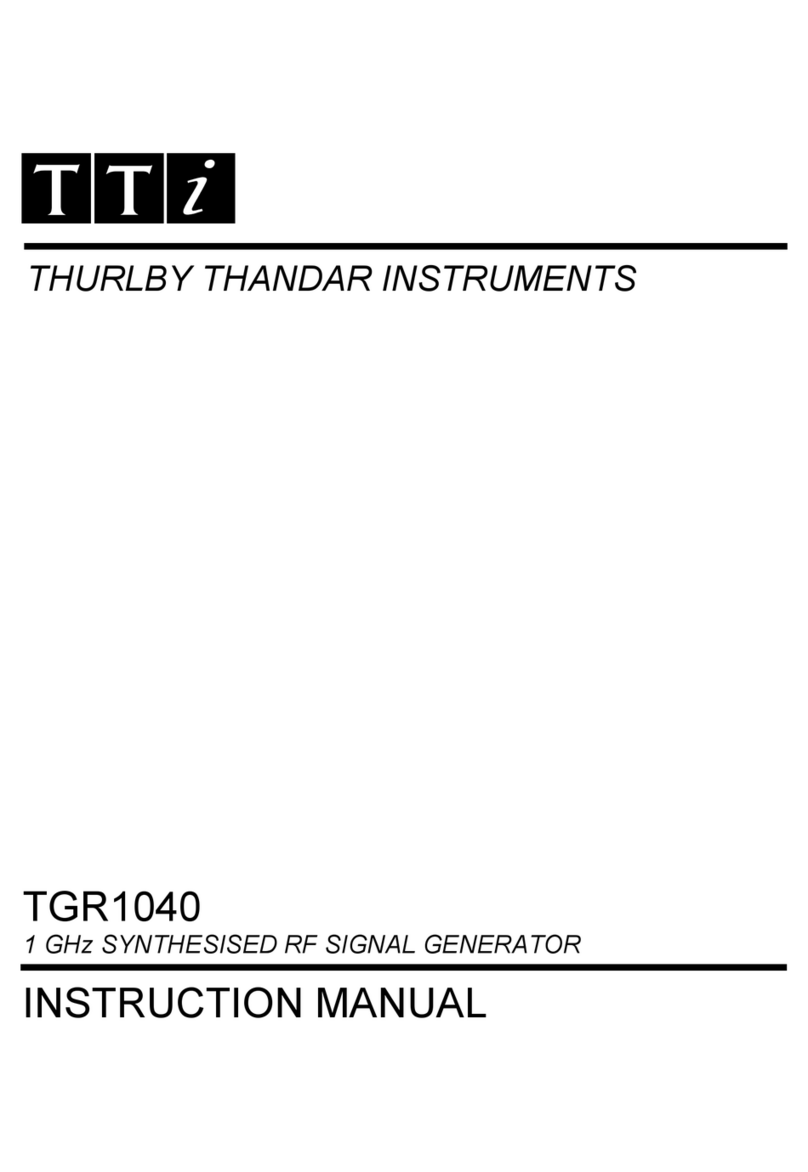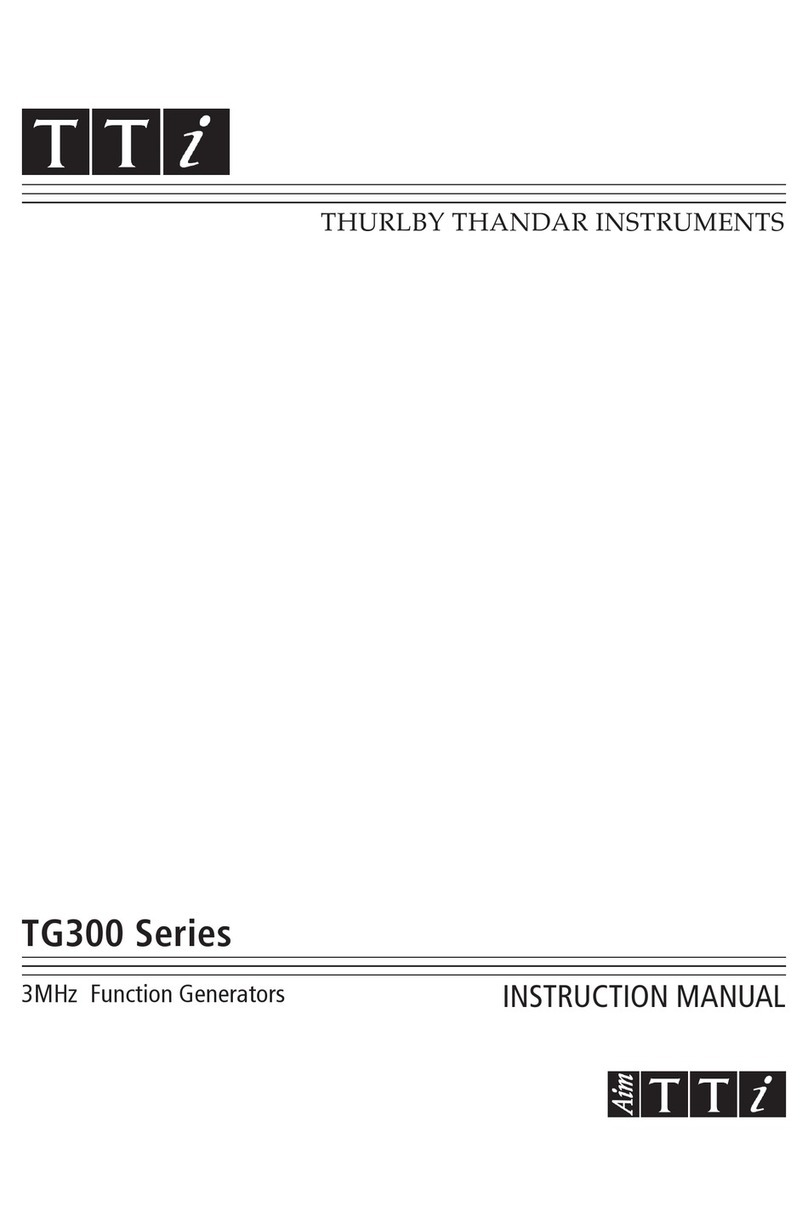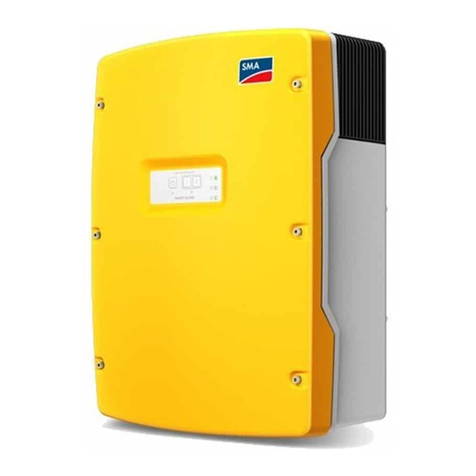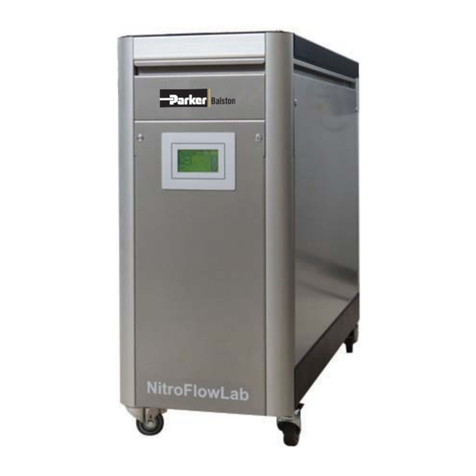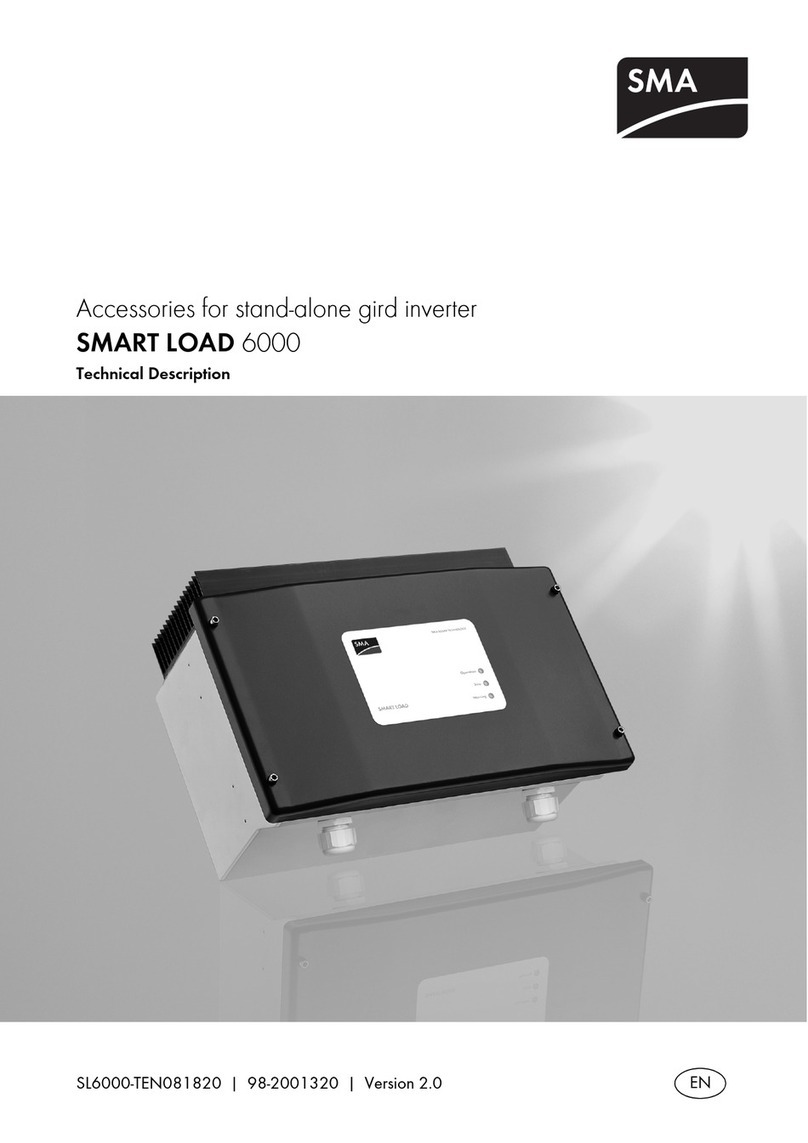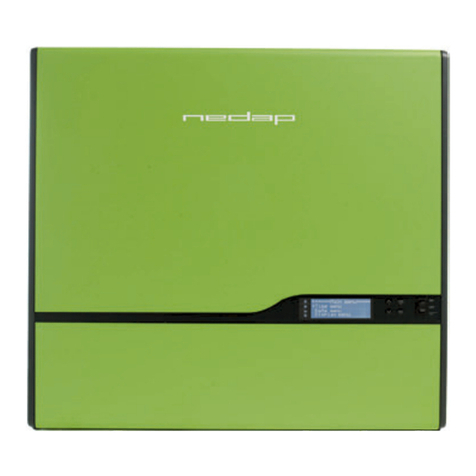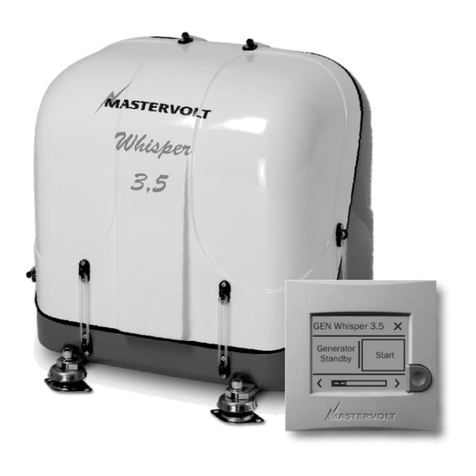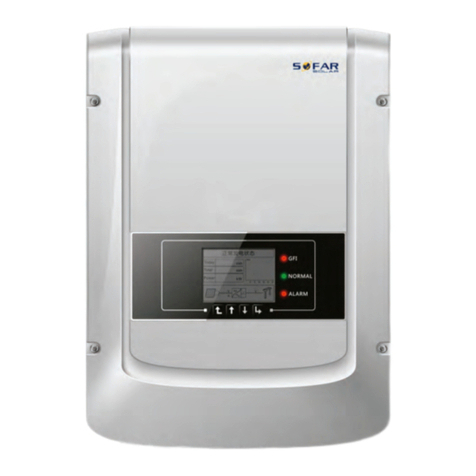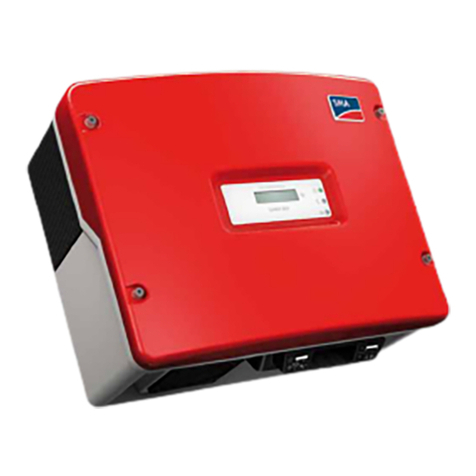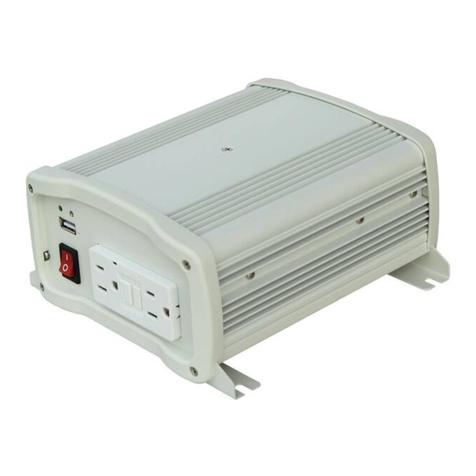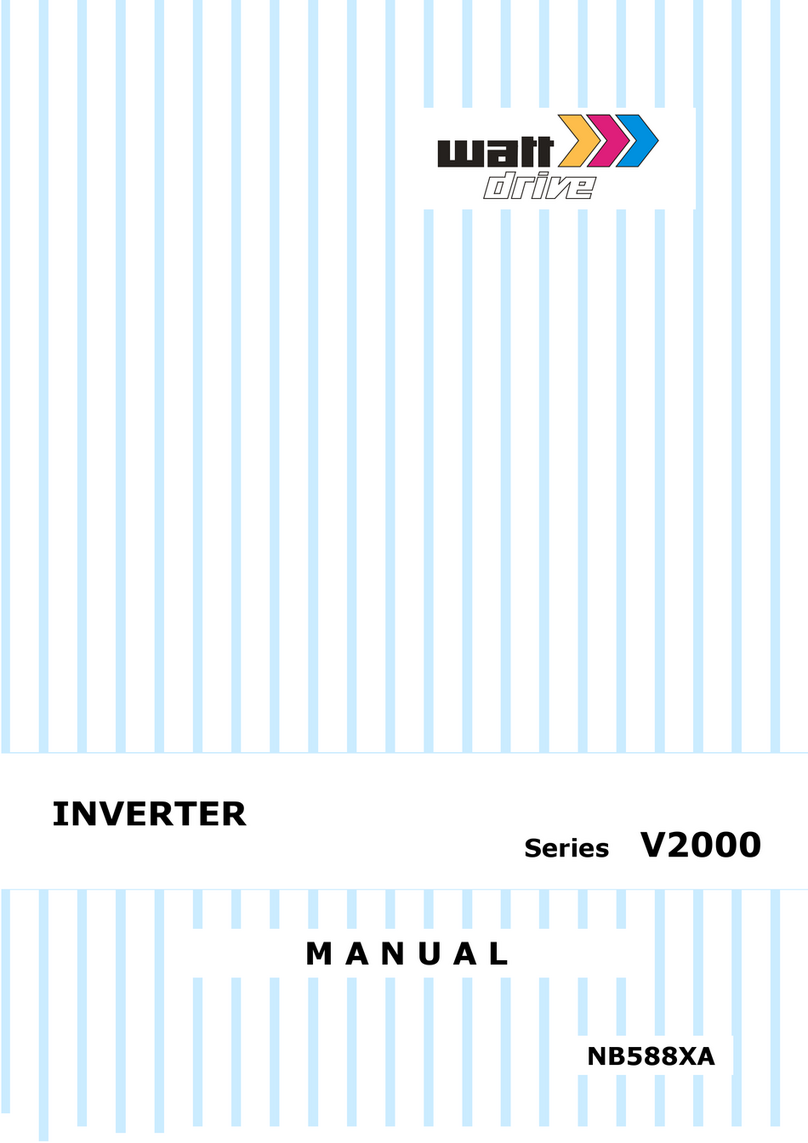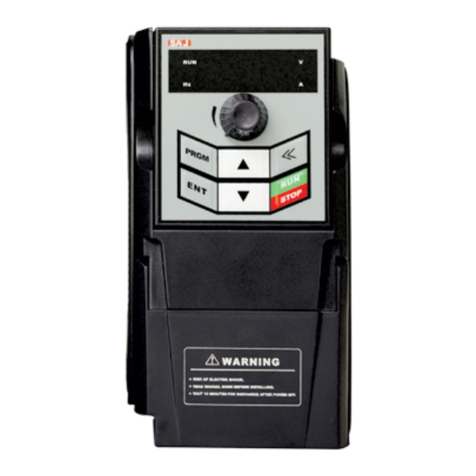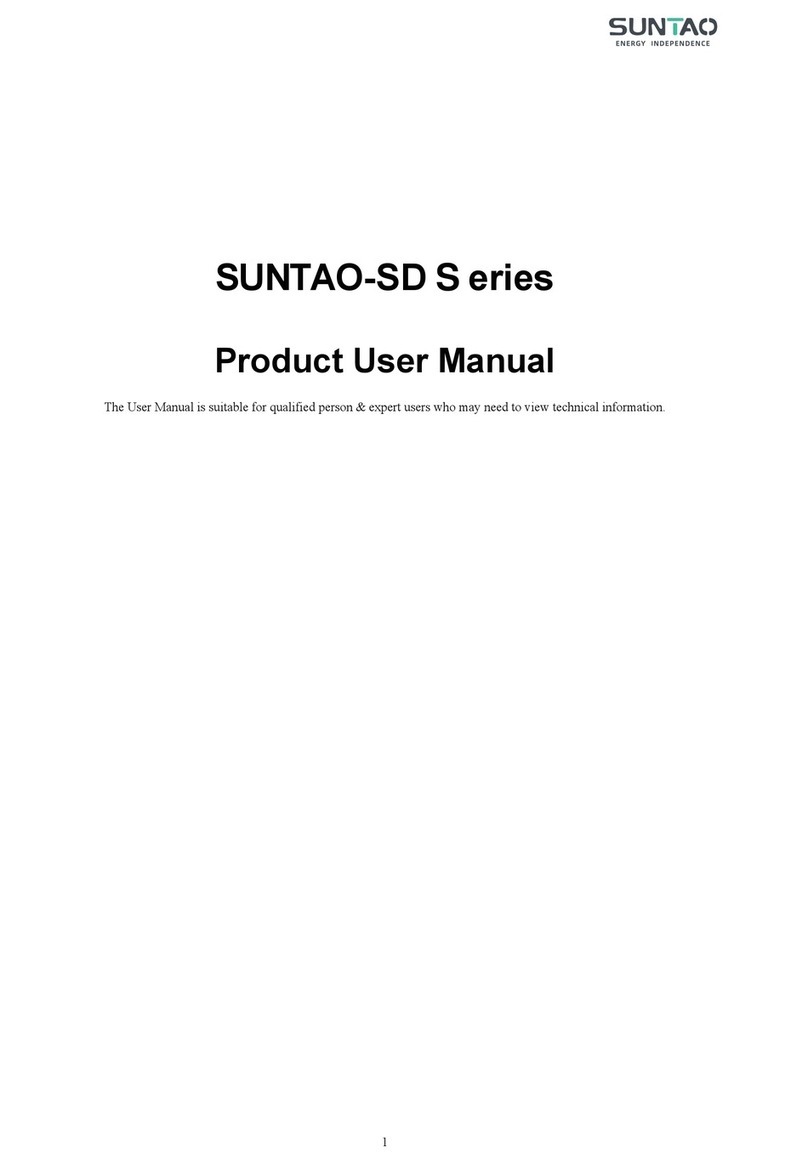Thurlby Thandar Instruments TGR2050 User manual

THURLBY THANDAR INSTRUMENTS
2 GHz SYNTHESISED RF SIGNAL GENERATOR
TGR2050
INSTRUCTION MANUAL

Introduction
This low cost synthesised RF signal generator features a wide amplitude range, low noise and
inherently good frequency stability. The generator also features internal and external FM, AM and
Phase Modulation. The instrument can be operated manually via the front panel or remotely
controlled via the RS232 or GPIB interfaces.
It is suitable for radio receiver sensitivity measurements, system gain measurements, oscillator
substitutions, EMC/antenna/field strength measurements and as a signal source for many other
RF circuit and system development tasks. In addition, the generator's low cost, ease of use and
remote control make it eminently suitable for most production and development applications
where a basic, stable signal source is required.
Table of Contents
Specification 3
EMC 7
Safety 8
Installation 9
Connections 10
Operation 11
Remote Operation 15
Remote Commands 23
Maintenance 27
Appendix 1. Error Messages 28
Appendix 2. Factory Defaults 29
Instructions en Francais
Sécurité 30
Installation 31
Connexions 32
Fonctionnement 34
Fonctionnement à distance 38
Commandes à distance 46
Maintenance 50
Annexe1. Messages d'erreur 51
Annexe 2. Réglages par défaut en usine 52
Bedienungsanleitung auf Deutsch
Sicherheit 53
Installation 54
Anschlüsse 55
Betrieb 56
Fernbedienung 60
Fernbedienungs-Befehle 68
Wartung 72
Anhang 1 Fehlermeldungen 73
Anhang 2 - Werkseinstellungen 74
1

Istruzioni in Italiano
Sicurezza 75
Installazione 76
Collegamenti 77
Funzionamento 79
Operazione a distanza 83
Comandi a Distanza 91
Manutenzione 95
Appendice 1. Messaggi d’Errore 96
Appendice 2. Defaults di Fabbrica 97
Instrucciones en Español
Seguridad 98
Instalación 99
Conexiones 100
Funcionamiento 102
Funcionamiento Remoto 106
Comandos Remotos 114
Mantenimiento 118
Apéndice 1. Mensajes de Error 119
Apéndice 2. Valores Predeterminados de Fábrica 120
2

Specification
FREQUENCY
Frequency Range: 150kHz – 2000MHz
Setting Resolution: 10Hz
Accuracy/stability: see Reference Frequency
Phase Noise: <–116dBc @ 25kHz offset, 500MHz Carrier.
Residual FM: 12Hz @ 500MHz – Equivalent peak deviation in a 300Hz to 3.4kHz
bandwidth.
REFERENCE FREQUENCY
Internal Reference Accuracy: <± 1ppm, 15ºC – 30ºC
<± 2ppm, 5ºC – 40ºC
Internal Reference Stability: <1ppm/year
Reference In/Out: Rear panel BNC; can be disabled when not required for input or
output.
External Reference IN: 10MHz, 50Ωinput impedance, 2 - 5Vpp
Automatic detection and selection when external reference signal is
present and Reference IN is selected on front panel.
Front panel LED indication when external is active.
Internal Reference OUT: 10MHz, 50Ωoutput impedance, >2Vpp into 50Ω
Signal present when Reference OUT is selected on the front panel
OUTPUT LEVEL
Output Level range: –127dBm – +7dBm, all modes except AM
–127dBm – +1dBm, AM mode
Setting Resolution: 0.1dB, 0.01uV –1mV
Accuracy: ± 2dBm
Harmonically Related Signals: <–25dBc @ +7dBm
Sub-harmonically Related
Signals:
≤1000MHz : None
>1000MHz : <–20dBc @ +7dBm
Non-harmonic Spurii: ≥62.5MHz : <–60dBc
<62.5MHz : <–50dBc (150kHz – 250MHz bandwidth)
Carrier Leakage: <0.5µV generated into a 50Ωload by a two turn 25mm loop 25mm
from the generator with the output set to ≤–10dBm into a sealed
50Ωload.
Output Impedance: 50Ω
Output Connector: Type N
Reverse Power Protection: 50V DC, up to 25W from 50Ωsource. Flashing LED indication.
Output Switch: RF OUT On/Off switch with LED showing ON status
3

MODULATION SOURCE
Internal: 400Hz and 1kHz sine derived from reference frequency.
External: Calibrated for 1Vrms sine into 600Ω
Connector: Front Panel BNC provides modulation input when external
modulation is selected and outputs internal modulation when
internal is selected.
Modulation I/O Impedance: 600Ω
Output Level: 1Vrms EMF from 600Ωsource impedance.
Maximum Input: 20V rms
FREQUENCY MODULATION
Max Peak Deviation: 800kHz, 1000MHz – 2000MHz
400kHz, 500MHz – 999.99999MHz
200kHz, 250MHz – 499.99999MHz
100kHz, 125MHz – 249.99999MHz
50kHz, 62.5MHz – 124.99999MHz
100kHz, 150kHz – 62.49999MHz
Setting Resolution: 0.5kHz
Deviation Accuracy: <±10% ±0.5kHz for 1kHz Internal or 1kHz, 1Vrms External
Modulation.
Modulation Signal: Internal or External 100Hz – 300kHz (±2dB relative to 1kHz)
Distortion: <2% @1kHz modulation, max. deviation (300-3.4kHz bandwidth)
PHASE MODULATION
Max Peak Deviation: 80.0rads 1000MHz – 2000MHz
40.0rads 500MHz – 999.99999MHz,
20.0rads 250MHz – 499.99999MHz,
10.0rads 125MHz – 249.99999MHz,
5.0rads 62.5MHz – 124.99999MHz,
10.0rads 150kHz – 62.49999MHz
Setting Resolution: 0.05rads <10.0rads deviation, 0.1rad >=10.0rads deviation
Deviation Accuracy: <±10% ±0.05rads for 1kHz Internal or 1kHz, 1Vrms External
Modulation.
Modulation Signal: Internal or External 100Hz – 10kHz (±2dB relative to 1kHz)
Distortion: <2% @ 1kHz modulation, max. deviation (300-3.4kHz bandwidth)
AMPLITUDE MODULATION
Max Modulation Depth: 100%, usability decreasing to 90% at 2GHz
Setting Resolution: 0.5%
Accuracy: < ±(5% setting +1%) for 1kHz Internal or 1kHz, 1Vrms External
Modulation, <70% depth.
Modulation Signal: Internal or External 50Hz – 200kHz (±1dB relative to 1kHz)
Distortion - 150kHz – 1GHz: ≤3% @ 30% depth, ≤5% @ 70% depth
1GHz – 2GHz: ≤5% @ 30% depth, ≤10% @ 70% depth
@ 1kHz modulation, 300-3.4kHz measurement bandwidth.
4

INTERFACES
RS232 Variable Baud rate, 19200 Baud maximum, Addressable RS232
Chain (ARC) compatible.
IEEE Conforming to IEEE488-1, IEEE488-2
GENERAL
Power: 220 - 240VAC or 110 - 120VAC ±10%, 50/60Hz, adjustable
internally; 30VA max. Installation Category II.
Display 20 character x 4 row backlit alphanumeric LCD
Data Entry: Keyboard selection of all major parameters or stepping by user
selected increment values using up/down keys or rotary control.
Stored Settings: Up to 9 complete set-ups.
Operating Range: +5°C to +40°C, 20 - 80% RH
Storage Range: –20°C to + 60°C
Environmental: Indoor use at altitudes up to 2000m, Pollution Degree 2.
EMC: Complies with EN61326
Safety: Complies with EN61010-1
Size: 3U high, half rack width.
Weight: 5.0 kg
Options: 19 inch rack mounting kit.
5

EC Declaration of Conformity
We Thurlby Thandar Instruments Ltd
Glebe Road
Huntingdon
Cambridgeshire PE29 7DR
England
declare that the
TGR2050 2GHz Synthesised RF Signal Generator
meets the intent of the EMC Directive 2004/108/EC and the Low Voltage Directive 2006/95/EC.
Compliance was demonstrated by conformance to the following specifications which have been
listed in the Official Journal of the European Communities.
EMC
Emissions: a) EN61326-1 (2006) Radiated, Class B
b) EN61326-1 (2006) Conducted, Class B
c) EN61326-1 (2006) Harmonics, referring to EN61000-3-2 (2006)
Immunity: EN61326-1 (2006) Immunity Table 1, referring to:
a) EN61000-4-2 (1995) Electrostatic Discharge
b) EN61000-4-3 (2006) Electromagnetic Field
c) EN61000-4-11 (2004) Voltage Interrupt
d) EN61000-4-4 (2004) Fast Transient
e) EN61000-4-5 (2006) Surge
f) EN61000-4-6 (2007) Conducted RF
Performance levels achieved are detailed in the user manual.
Safety
EN61010-1 Installation Category II, Pollution Degree 2.
CHRIS WILDING
TECHNICAL DIRECTOR
1 May 2009
6

EMC
This instrument has been designed to meet the requirements of the EMC Directive 2004/108/EC.
Compliance was demonstrated by meeting the test limits of the following standards:
Emissions
EN61326-1 (2006) EMC product standard for Electrical Equipment for Measurement, Control and
Laboratory Use. Test limits used were:
a) Radiated: Class B
b) Conducted: Class B
c) Harmonics: EN61000-3-2 (2006) Class A; the instrument is Class A by product category.
Immunity
EN61326-1 (2006) EMC product standard for Electrical Equipment for Measurement, Control and
Laboratory Use.
Test methods, limits and performance achieved are shown below (requirement shown in
brackets):
a) EN61000-4-2 (1995) Electrostatic Discharge : 4kV air, 4kV contact, Performance A (B).
b) EN61000-4-3 (2006) Electromagnetic Field:
3V/m, 80% AM at 1kHz, 80MHz – 1GHz: Performance A (A) and 1.4GHz to 2GHz:
Performance A (A); 1V/m, 2.0GHz to 2.7GHz: Performance A (A).
c) EN61000-4-11 (2004) Voltage Interrupt: ½ cycle and 1 cycle, 0%: Performance A (B);
25 cycles, 70% and 250 cycles, 0%: Performance B* (C).
* To achieve Performance B for 250 cycles, 0%, status of RF OUT at power-up must be
set to be the same as at power-down, otherwise Performance C is achieved (requires
operator to turn on RF OUT).
d) EN61000-4-4 (2004) Fast Transient, 1kV peak (AC line), 0·5kV peak (signal connections),
Performance A (B).
e) EN61000-4-5 (2006) Surge, 0·5kV (line to line), 1kV (line to ground), Performance A (B).
f) EN61000-4-6 (2007) Conducted RF, 3V, 80% AM at 1kHz (AC line only; signal
connections <3m, therefore not tested), Performance A (A).
According to EN61326-1 the definitions of performance criteria are:
Performance criterion A: ‘During test normal performance within the specification limits.’
Performance criterion B: ‘During test, temporary degradation, or loss of function or
performance which is self-recovering’.
Performance criterion C: ‘During test, temporary degradation, or loss of function or
performance which requires operator intervention or system reset occurs.’
Cautions
To ensure continued compliance with the EMC directive observe the following precautions:
a) Connect the generator to other equipment using only high quality, double-screened cables.
b) After opening the case for any reason ensure that all signal and ground connections are
remade correctly and that case screws are correctly refitted and tightened.
c) In the event of part replacement becoming necessary, only use components of an identical
type, see the Service Manual.
7

Safety
This instrument is Safety Class I according to IEC classification and has been designed to meet
the requirements of EN61010-1 (Safety Requirements for Electrical Equipment for Measurement,
Control and Laboratory Use). It is an Installation Category II instrument intended for operation
from a normal single phase supply.
This instrument has been tested in accordance with EN61010-1 and has been supplied in a safe
condition. This instruction manual contains some information and warnings which have to be
followed by the user to ensure safe operation and to retain the instrument in a safe condition.
This instrument has been designed for indoor use in a Pollution Degree 2 environment in the
temperature range 5°C to 40°C, 20% - 80% RH (non-condensing). It may occasionally be
subjected to temperatures between +5°C and –10°C without degradation of its safety. Do not
operate while condensation is present.
Use of this instrument in a manner not specified by these instructions may impair the safety
protection provided. Do not operate the instrument outside its rated supply voltages or
environmental range.
WARNING! THIS INSTRUMENT MUST BE EARTHED
Any interruption of the mains earth conductor inside or outside the instrument will make the
instrument dangerous. Intentional interruption is prohibited. The protective action must not be
negated by the use of an extension cord without a protective conductor.
When the instrument is connected to its supply, terminals may be live and opening the covers or
removal of parts (except those to which access can be gained by hand) is likely to expose live
parts. The apparatus shall be disconnected from all voltage sources before it is opened for any
adjustment, replacement, maintenance or repair.
Any adjustment, maintenance and repair of the opened instrument under voltage shall be avoided
as far as possible and, if inevitable, shall be carried out only by a skilled person who is aware of
the hazard involved.
If the instrument is clearly defective, has been subject to mechanical damage, excessive moisture
or chemical corrosion the safety protection may be impaired and the apparatus should be
withdrawn from use and returned for checking and repair.
Make sure that only fuses with the required rated current and of the specified type are used for
replacement. The use of makeshift fuses and the short-circuiting of fuse holders is prohibited.
This instrument uses a Lithium button cell for non-volatile memory battery back-up; typical life is 5
years. In the event of replacement becoming necessary, replace only with a cell of the correct
type, i.e. 3V Li/Mn0220mm button cell type 2032. Exhausted cells must be disposed of carefully
in accordance with local regulations; do not cut open, incinerate, expose to temperatures above
60°C or attempt to recharge.
Do not wet the instrument when cleaning it and in particular use only a soft dry cloth to clean the
LCD window. The following symbols are used on the instrument and in this manual:-
Caution -refer to the accompanying documentation,
incorrect operation may damage the instrument.
terminal connected to chassis ground.
mains supply OFF.
l mains supply ON.
alternating current.
8

Installation
Check that the instrument operating voltage marked on the rear panel is suitable for the local
supply. Should it be necessary to change the operating voltage, proceed as follows:
1) Disconnect the instrument from all voltage sources.
2) Remove the screws which retain the top cover and lift off the cover.
3) Change the transformer connections following the appropriate diagram below:
115V OPERATION 230V OPERATION
4) Refit the cover and secure with the same screws.
5) To comply with safety standard requirements the operating voltage marked on the rear panel
must be changed to clearly show the new voltage setting.
6) Change the fuse to one of the correct rating, see below.
Fuse
Ensure that the correct mains fuse is fitted for the set operating voltage. The correct mains fuse
types are:
for 230V or 115V operation: 1A (T) 250 V HRC
To replace the fuse, disconnect the mains lead from the inlet socket and release the fuse drawer
below the socket pins by depressing both clips together, with miniature screwdrivers, so that the
drawer can be eased open. Change the fuse and replace the drawer.
The use of makeshift fuses or the short-circuiting of the fuse holder is prohibited.
Mains Lead
When a three core mains lead with bare ends is provided it should be connected as follows:-
Brown - Mains Live
Blue - Mains Neutral
Green / Yellow - Mains Earth
WARNING! THIS INSTRUMENT MUST BE EARTHED
Any interruption of the mains earth conductor inside or outside the instrument will make the
instrument dangerous. Intentional interruption is prohibited. The protective action must not be
negated by the use of an extension cord without a protective conductor.
Mounting
This instrument is suitable both for bench use and rack mounting. It is delivered with feet for
bench mounting. The front feet include a tilt mechanism for optimal panel angle.
A rack kit for mounting one or two of these Half-width 3U high units in a 19” rack is available from
the Manufacturers or their overseas agents.
9

Connections
Front Panel Connections
RF OUT
This is the 50Ωgenerator output. The maximum output is 500mVrms (+7dBm) into 50Ω. It can
tolerate a short circuit indefinitely.
The Type N connector is a precision component that should be protected from excessive wear to
ensure that its RF characteristics (impedance and VSWR) are accurately maintained. If the
instrument is used in a manner that demands many connections/disconnections to and from the
RF OUT it is good practice to fit a male–to–female adaptor to the socket which can be replaced
periodically.
Do not apply an external voltage to this output. Protected against accidental connection of up to
50VDC and reverse power of up to 25 Watts from 50Ω.
MODULATION IN/OUT
This is the external modulation input and internal modulation output. Input frequency range is
50Hz to 300kHz (depending on modulation type) and impedance is nominally 600Ω as input or
output.
Do not apply external voltages exceeding ± 10V peak to this input/output.
Rear Panel Connections
EXTERNAL REFERENCE IN/OUT
Can be set to be the External Reference In (10MHz, 2V to 5Vpp, 50Ω), Internal Reference Out
(10MHz, 4Vpp from 50Ω) or Off.
Do not apply external voltages exceeding ± 10Vpp to this input/output.
RS232
9-pin D-connector compatible with addressable RS232 use. The pin connections are shown
below:
Pin Name Description
1 - No internal Connection
2 TXD Transmitted data from instrument
3 RXD Received data to instrument
4 - No internal connection
5 GND Signal ground
6 - No internal connection
7 RXD2 Secondary received data (addressable RS232 only)
8 TXD2 Secondary transmitted data (addressable RS232 only)
9 GND Signal ground (addressable RS232 only)
Pins 2, 3 and 5 may be used as a conventional RS232 interface with XON/XOFF handshaking.
Pins 7,8 and 9 are additionally used when the instrument is used in addressable RS232 mode.
Signal grounds are connected to instrument ground. The RS232 address is set from the front
panel using the COMMS menu.
GPIB (IEEE-488)
The GPIB interface is not isolated; the GPIB signal grounds are connected to the instrument
ground. The implemented subsets are:
SH1 AH1 T6 TE0 L4 LE0 SR1 RL1 PP1 DC1 DT0 C0 E2
The GPIB address is set from the front panel using the C0MMS menu.
10

Operation
General
This section is a general introduction to the operation of the generator, intended to be read before
using the instrument for the first time.
Switching On
The power switch is located at the bottom left of the front panel.
At power up the generator displays the installed software revision for 2 seconds before reverting
to the main menu. The factory default is for the RF OUT output to be always off at switch on but
this can be changed, see the RF OUT Setting at Switch On section; all the other settings will be
the same as when the instrument was last powered down. Should an error with the battery-
backed RAM be encountered at power up a message will be displayed, see the Error Messages
section.
The basic generator parameters can all be set from this main menu as described in the following
sections. The output is switched on with the RF OUT key; the ON lamp will light to show that the
output is on.
Keyboard Principles
The keys can be considered in the following groups:
• The numeric/unit keys permit direct entry of a value for the parameter currently selected
(indicated by the ►cursor beside the parameter). Thus, with frequency selected,
123.45689 MHz is set by keying 1, 2, 3, • , 4, 5, 6, 8, 9 MHz. The parameter actually changes
only when the units key (dB, MHz, etc.) is pressed.
FREQUENCY can be entered in kHz, MHz, or GHz but will always be displayed in MHz.
LEVEL can be entered in dBm, mV or µV; mV values below 1.00mV will be displayed in µV
and µV values above 1000µV will be displayed in mV. With the ►cursor set to LEVEL the
value displayed can be switched from dBm to µV/mV and vice-versa by pressing the
appropriate key.
To enter negative numbers (for dB) the ± key can be used at any time during the number
entry.
ESCAPE aborts the entry and leaves the parameter at its previous setting.
• To the left of the numeric keys are the 5 parameter keys which select the parameter to be
changed; the ►cursor moves to the selected parameter and that parameter can then be
changed as described above.
Next to the MODULATION TYPE key is the MODULATION ON/OFF key which turns
modulation on and off with alternate presses; the MODULATION lamp lights when modulation
is on.
• The FIELD keys provide an alternative means of moving the ►cursor between parameters
on a menu. The rotary control and the ▲▼keys below it provide alternative means of
incrementing/decrementing the value of the currently selected parameter (for FREQUENCY
and LEVEL) or stepping through the parameter settings (for ADDRESS, etc.). When
incrementing/decrementing frequency and level the parameter value changes in steps set up
on the STEP SIZE menu, see Step Size section. During numeric entries the ▼key also acts
as a backspace/delete.
• The COMMS key selects the communications menu and allows the communication interface
parameters to be set up. When the instrument is in remote control the COMMS key doubles
as the LOCAL key, which returns the instrument to local (keyboard) control.
11

• The UTILITIES key selects the Utilities menu which gives access to the stored set-up,
reference socket control and buzzer control.
• The EXECUTE key is used to confirm operations other than numeric parameter entries,
e.g. during store and recall of set-ups.
Step Size
When changing the FREQUENCY or LEVEL using the rotary control or ▲▼keys the size of each
step change will be that previously set on the Step Size menu. The default FREQUENCY step is
0.1MHz. The defaults for the two separate LEVEL step sizes are 10dB and 10mV; the active
LEVEL step size is the one currently displayed in the Step Size menu. Note that either LEVEL
step setting can be used with either LEVEL display mode; i.e. mV steps can be used in a dB
display and vice-versa. However, it will generally be most useful to use dB steps in a dB level
display and µV/mV steps in a µV/mV display.
To change the step size, select the STEP SIZE menu and move the ►selection cursor to the
required parameter with the FIELD keys. Alternatively, because the cursor automatically points to
the step size of the most recently selected main menu parameter, pressing FREQUENCY
followed by STEP SIZE will set the ►cursor to frequency step size and pressing LEVEL followed
by STEP SIZE will set the cursor to level step size.
FREQUENCY steps can be entered directly from the keyboard in kHz, MHz or GHz but will
always be displayed in MHz. The smallest step that can be set is 10Hz and this is the amount by
which the step is changed if the rotary control or ▲▼keys are used; large changes in step size
are therefore made most quickly by direct keyboard entry.
LEVEL steps can be entered directly from the keyboard in dB or µV/mV; separate step sizes are
stored for dB and µV/mV and the choice of units will determine which of the two LEVEL steps is
changed. The active LEVEL step size is the one currently displayed; pressing dB or µV/mV will
switch between the two without changing either. Note that mV values below 1.00mV will be
displayed in µV and µV values above 1000µV will be displayed in mV. The smallest step size that
can be set is 0.1dB or 0.01µV; when using the rotary control or ▲▼keys to set step size the
amount by which the step is changed is 0 .1dB for dB steps or 1 least significant digit for µV/mV
steps.
Having set the step size, return to the main menu by pressing FREQUENCY or LEVEL, etc.
Setting Frequency
Set the ►cursor to FREQUENCY on the main menu by pressing the FREQUENCY key. The
generator frequency can then be set directly from the keyboard, in kHz, MHz or GHz, or changed
using the rotary control or ▲▼keys. Refer to Keyboard Principles for further information on
keyboard entries and to Step Size for setting the rotary control and ▲▼key increment size.
Note that when an increment would have taken the frequency above the instrument's maximum,
the setting becomes 2000 MHz. The next decrement returns the frequency to the last in-range
setting and further decrements decrease the frequency by the specified step size. Similarly when
a decrement would have taken the frequency below the instrument's minimum the setting
becomes 150kHz and the next increment returns the frequency to the last in-range setting, etc.
Setting Level
Set the ►cursor to LEVEL on the main menu by pressing the LEVEL key. The output level can
then be set directly from the keyboard, in dBm or µV/mV, or changed using the rotary control or
▲▼ keys. Refer to Keyboard Principles for further information on keyboard entries and to Step
Size for setting the rotary control and ▲▼key increment size.
12

Note that when an increment would have taken the level above the instrument's maximum output
the setting becomes +7dBm (or 500mV). The next decrement returns the level to the last in-range
setting and further decrements reduce the level by the specified step size. Similarly when a
decrement would have taken the level below the instrument's minimum the setting becomes
–127dBm (or 0.1µV) and the next increment returns the setting to the last in-range setting, etc.
Modulation
The generator can be set for internal or external AM, FM or Phase Modulation (PM). With the ►
selection cursor in the MODulation field of the main menu, successive presses of the TYPE key
will step the generator through all available combinations of internal and external AM, FM and
PM; alternatively the selection can be made by using the rotary control or ▲▼ keys.
Amplitude Modulation (AM)
The choices are INTernal at 400Hz, INTernal at 1kHz or EXTernal; with EXTernal selected the
specified modulation frequency range can be applied to the MODULATION IN/OUT socket.
With AM selected the DEPTH/DEVIATION field automatically displays DEPTH. With the ►
selection cursor in the depth field the modulation depth can be set directly from the keyboard in
%, or changed using the rotary control or ▲▼ keys; modulation depth can be set from 0.5% to
100% in 0.5% increments.
With EXTernal modulation selected, the specified modulation depth is achieved with a 1Vrms
sinewave modulation signal.
With AM selected the maximum RF output level is +1.0dBm. If a higher output level has been set
(with AM and/or RF OUT off) then a warning message “+1dBm MAX WITH AM ON” will show
temporarily and the RF OUT level will be reduced to +1dBm. The output level setting will remain
at +1dBm when AM and/or RF OUT are turned off.
Frequency Modulation (FM)
The choices are INTernal at 400Hz, INTernal at 1kHz or EXTernal; with EXTernal selected the
specified modulation frequency range can be applied to the MODULATION IN/OUT socket.
With FM selected the DEPTH/DEVIATION field automatically displays Peak DEViation. With the
►selection cursor in the PK. DEV field the peak deviation can be set directly from the keyboard,
in kHz, MHz or GHz, or changed using the rotary control or ▲▼ keys; peak deviation can be set
to a resolution of 0.5kHz.
With EXTernal modulation selected, the specified peak deviation is achieved with a 1Vrms
sinewave modulation signal.
The maximum peak deviation achievable depends on the carrier frequency, see Specification
section. If a peak deviation is entered (with MOD ON) which is greater than the maximum for the
set carrier frequency then a warning message “PK. DEV LIMITED BY CARRIER FREQUENCY”
will show temporarily and the peak deviation will be changed to the maximum permitted for the
set carrier frequency. The peak deviation frequency in the display is marked with a ∗to show that
it differs from that entered; the entered value will be restored when FM and/or MOD ON/OFF are
turned off.
The default FM settings are internal 1kHz modulation, 50kHz peak deviation, modulation off; FM
is also the instrument’s default modulation setting.
Phase Modulation (PM)
The choices are INTernal at 400Hz, INTernal at 1kHz or EXTernal; with EXTernal selected the
specified modulation frequency range can be applied to the MODULATION IN/OUT socket.
With PM selected the DEPTH/DEVIATION field automatically displays Peak DEViation. With the
►selection cursor in the PK. DEV field the peak deviation can be set directly from the keyboard,
in rads, or changed using the rotary control or ▲▼ keys; peak deviation can be set to a
resolution of 0.05 rads up to 10.0 rads and to a resolution of 0.1 rads above 10.0 rads.
13

With EXTernal modulation selected, the specified peak deviation is achieved with a 1Vrms
sinewave modulation signal.
The maximum peak deviation achievable depends on the carrier frequency, see Specification
section. If a peak deviation is entered (with MOD ON) which is greater than the maximum for the
set carrier frequency then a warning message “PK. DEV LIMITED BY CARRIER FREQUENCY”
will show temporarily and the peak deviation will be changed to the maximum permitted for the
set carrier frequency. The peak deviation frequency in the display is marked with a ∗to show that
it differs from that entered; the entered value will be restored when PM and/or MOD ON/OFF are
turned off.
The default PM settings are internal 1kHz modulation, 5.00 rads peak deviation, modulation off.
RF OUT Setting at Switch On
The factory default is for the RF OUT output to always be off at switch on, but this can be
changed as follows.
Hold down the ▼edit key at instrument switch on; after a few seconds a special screen is
displayed. Scroll through the choices using the ▲key until the required mode is displayed
(always off, always on, or same state as at last power-down). Press EXECUTE to confirm the
selection and exit the menu.
Storing and Recalling Set-ups
Complete instrument set-ups can be stored or recalled from non-volatile RAM using the STORE
and RECALL facilities on the Utilities menu, accessed by pressing the UTILITIES key.
With the ►selection cursor in the STORE field of the Utilities menu the store to be used can be
selected with the rotary control or ▲▼ keys. Nine stores, numbered 1 to 9 inclusive are available.
Select the required store and press the EXECUTE key; the display requests that you press
EXECUTE again to confirm the operation (or any other key to cancel). A set-up already in that
store will be overwritten. The status of the RF OUT is ignored; when a store is recalled the RF
OUT will remain as previously set.
With the ►cursor in the RECALL field of the Utilities menu a previously stored set-up, or the
factory defaults, can be recalled. Select the required store, or DEFAULTS for factory defaults, and
press the EXECUTE key; the display requests that you press EXECUTE again to confirm (or any
other key to cancel). If there is no valid data in the specified store the message 'NO VALID DATA
IN STORE' will be displayed and the set-up will remain unchanged.
14

Remote Operation
The instrument can be remotely controlled via its RS232 or GPIB interfaces. When using RS232
it can either be the only instrument connected to the controller or it can be part of an Addressable
RS232 Chain (ARC) which permits up to 32 instruments to be addressed from one RS232 port.
Some of the following sections are general and apply to all 3 modes (single instrument RS232,
ARC and GPIB); others are clearly only relevant to a particular interface or mode. It is only
necessary to read the general sections plus those specific to the intended remote control mode.
Remote command format and the remote commands themselves are detailed in the Remote
Commands chapter.
Address and Baud Rate Selection
For successful operation, each instrument connected to the GPIB or Addressable RS232 Chain
(ARC) must be assigned a unique address and, in the case of addressable RS232, all must be
set to the same Baud rate.
The instrument’s remote address for operation on both the GPIB and RS232 interfaces is set on
the COMMS menu, accessed by pressing the COMMS key. With the ►selection cursor in the
ADDRESS field the address can be changed using the rotary control or ▲▼keys. On this
instrument addresses 0 to 30 inclusive are allowed; the factory default is address 1. The address
setting is ignored in single instrument RS232 operation.
With the ►selection cursor in the REMOTE field, the rotary control or ▲▼keys can be used to
select GPIB or RS232 with Baud rates of between 300 and 19200; the factory default selection is
RS232 at 9600 Baud.
Remote/Local Operation
At power-on the instrument will be in the local state with the REMOTE lamp off. In this state all
keyboard operations are possible. When the instrument is addressed to listen and a command is
received the remote state will be entered and the REMOTE lamp will be turned on. In this state
the keyboard is locked out and remote commands only will be processed. The instrument may be
returned to the local state by pressing the LOCAL key; however, the effect of this action will only
remain until the instrument is addressed again or receives another character from the interface,
when the remote state will once again be entered.
RS232 Interface
RS232 Interface Connector
The 9-way D-type serial interface connector is located on the instrument rear panel. The pin
connections are as shown below:
Pin Name Description
1 - No internal connection
2 TXD Transmitted data from instrument
3 RXD Received data to instrument
4 - No internal connection
5 GND Signal ground
6 - No internal connection
7 RXD2 Secondary received data (addressable RS232 only)
8 TXD2 Secondary transmitted data (addressable RS232 only)
9 GND Signal ground (addressable RS232 only)
15

Single Instrument RS232 Connections
For single instrument remote control only pins 2, 3 and 5 are connected to the PC. However, for
correct operation links must be made in the connector at the PC end between pins 1, 4 and 6 and
between pins 7 and 8, see diagram. Pins 7 and 8 of the instrument must not be connected to the
PC, i.e. do not use a fully wired 9–way cable.
Baud Rate is set as described above in Address and Baud Rate Selection; the other parameters
are fixed as follows:
Start Bits: 1 Parity: None
Data Bits: 8 Stop Bits: 1
Addressable RS232 Connections
For addressable RS232 operation pins 7, 8 and 9 of the instrument connector are also used.
Using a simple cable assembly, a ‘daisy chain’ connection system between any number of
instruments, up to the maximum of 32 can be made, as shown below:
The daisy chain consists of the transmit data (TXD), receive date (RXD) and signal ground lines
only. There are no control/handshake lines. This makes XON/XOFF protocol essential and allows
the inter-connection between instruments to contain just 3 wires. The wiring of the adaptor cable
is shown below:
16

All instruments on the interface must be set to the same baud rate and all must be powered on,
otherwise instruments further down the daisy chain will not receive any data or commands.
The other parameters are fixed as follows:
Start Bits: 1 Parity: None
Data Bits: 8 Stop Bits: 1
RS232 Character Set
Because of the need for XON/XOFF handshake it is possible to send ASCII coded data only;
binary blocks are not allowed. Bit 7 of ASCII codes is ignored, i.e. assumed to be low. No
distinction is made between upper and lower case characters in command mnemonics and they
may be freely mixed. The ASCII codes below 20H (space) are reserved for addressable RS232
interface control. In this manual 20H, etc. means 20 in hexadecimal
Addressable RS232 (ARC) Interface Control Codes
All instruments intended for use on the ARC bus use the following set of interface control codes.
Codes between 00H and 1FH which are not listed here as having a particular meaning are
reserved for future use and will be ignored. Mixing interface control codes inside instrument
commands is not allowed except as stated below for CR and LF codes and XON and XOFF
codes.
When an instrument is first powered on it will automatically enter the Non- Addressable mode. In
this mode the instrument is not addressable and will not respond to any address commands. This
allows the instrument to function as a normal RS232 controllable device. This mode may be
locked by sending the Lock Non-Addressable mode control code, 04H. The controller and
instrument can now freely use all 8 bit codes and binary blocks but all interface control codes are
ignored. To return to addressable mode the instrument must be powered off.
To enable addressable mode after an instrument has been powered on the Set Addressable
Mode control code, 02H, must be sent. This will then enable all instruments connected to the
ARC bus to respond to all interface control codes. To return to Non-Addressable mode the Lock
Non-Addressable mode control code must be sent which will disable addressable mode until the
instruments are powered off.
Before an instrument is sent a command it must be addressed to listen by sending the Listen
Address control code, 12H, followed by a single character which has the lower 5 bits
corresponding to the unique address of the required instrument, e.g. the codes A-Z or a-z give
the addresses 1-26 inclusive while @ is address 0 and so on. Once addressed to listen the
instrument will read and act upon any commands sent until the listen mode is cancelled.
Because of the asynchronous nature of the interface it is necessary for the controller to be
informed that an instrument has accepted the listen address sequence and is ready to receive
commands. The controller will therefore wait for Acknowledge code, 06H, before sending any
commands, The addressed instrument will provide this Acknowledge. The controller should time-
out and try again if no Acknowledge is received within 5 seconds.
Listen mode will be cancelled by any of the following interface control codes being received:
12H Listen Address followed by an address not belonging to this instrument.
14H Talk Address for any instrument.
03H Universal Unaddress control code.
04H Lock Non-Addressable mode control code.
18H Universal Device Clear.
Before a response can be read from an instrument it must be addressed to talk by sending the
Talk Address control code,14H, followed by a single character which has the lower 5 bits
corresponding to the unique address of the required instrument, as for the listen address control
code above. Once addressed to talk the instrument will send the response message it has
available, if any, and then exit the talk addressed state. Only one response message will be sent
each time the instrument is addressed to talk.
17

Talk mode will be cancelled by any of the following interface control codes being received:
12H Listen Address for any instrument.
14H Talk Address followed by an address not belonging to this instrument.
03H Universal Unaddress control code.
04H Lock Non-Addressable mode control code.
18H Universal Device Clear.
Talk mode will also be cancelled when the instrument has completed sending a response
message or has nothing to say.
The interface code 0AH (LF) is the universal command and response terminator; it must be the
last code sent in all commands and will be the last code sent in all responses.
The interface code 0DH (CR) may be used as required to aid the formatting of commands; it will
be ignored by all instruments. Most instruments will terminate responses with CR followed by LF.
The interface code 13H (XOFF) may be sent at any time by a listener (instrument or controller) to
suspend the output of a talker. The listener must send 11H (XON) before the talker will resume
sending. This is the only form of handshake control supported by ARC.
Full List of Addressable RS232 (ARC) Interface Control Codes
02H Set Addressable Mode.
03H Universal Unaddress control code.
04H Lock Non-Addressable mode control code.
06H Acknowledge that listen address received.
0AH Line Feed (LF); used as the universal command and response terminator.
0DH Carriage Return (CR); formatting code, otherwise ignored.
11H Restart transmission (XON).
12H Listen Address – must be followed by an address belonging to the required instrument.
13H Stop transmission (XOFF).
14H Talk Address – must be followed by an address belonging to the required instrument.
18H Universal Device Clear.
GPIB Interface
The GPIB interface 24-way connector is located on the instrument rear panel. The pin
connections are as specified in IEEE Std. 488.1-1987 and the instrument complies with IEEE Std.
488.1-1987 and IEEE Std. 488.2-1987.
GPIB Subsets
This instrument contains the following IEEE 488.1 subsets:
Source Handshake SH1
Acceptor Handshake AH1
Talker T6
Listener L4
Service Request SR1
Remote Local RL1
Parallel Poll PP1
Device Clear DC1
Device Trigger DT0
Controller C0
Electrical Interface E2
18

GPIB IEEE Std. 488.2 Error Handling
The IEEE 488.2 UNTERMINATED error (addressed to talk with nothing to say) is handled as follows.
If the instrument is addressed to talk and the response formatter is inactive and the input queue is
empty then the UNTERMINATED error is generated. This will cause the Query Error bit to be set in
the Standard Event Status Register, a value of 3 to be placed in the Query Error Register and the
parser to be reset. See the Status Reporting section for further information.
The IEEE 488.2 INTERRUPTED error is handled as follows. If the response formatter is waiting to
send a response message and a <PROGRAM MESSAGE TERMINATOR> has been read by the parser
or the input queue contains more than one END message then the instrument has been
INTERRUPTED and an error is generated. This will cause the Query Error bit to be set in the
Standard Event Status Register, a value of 1 to be placed in the Query Error Register and the
response formatter to be reset thus clearing the output queue. The parser will then start parsing
the next <PROGRAM MESSAGE UNIT> from the input queue. See the Status Reporting section for
further information.
The IEEE 488.2 DEADLOCK error is handled as follows. If the response formatter is waiting to send
a response message and the input queue becomes full then the instrument enters the DEADLOCK
state and an error is generated. This will cause the Query Error bit to be set in the Standard Event
Status Register, a value of 2 to be placed in the Query Error Register and the response formatter
to be reset thus clearing the output queue. The parser will then start parsing the next <PROGRAM
MESSAGE UNIT> from the input queue. See the Status Reporting section for further information.
GPIB Parallel Poll
Complete parallel poll capabilities are offered on this generator. The Parallel Poll Enable Register
is set to specify which bits in the Status Byte Register are to be used to form the ist local message
The Parallel Poll Enable Register is set by the ∗PRE <nrf> command and read by the ∗PRE?
command. The value in the Parallel Poll Enable Register is ANDed with the Status Byte Register;
if the result is zero then the value of ist is 0 otherwise the value of ist is 1.
The instrument must also be configured so that the value of ist can be returned to the controller
during a parallel poll operation. The instrument is configured by the controller sending a Parallel
Poll Configure command (PPC) followed by a Parallel Poll Enable command (PPE). The bits in
the PPE command are shown below:
bit 7 = X don’t care
bit 6 = 1
bit 5 = 1 Parallel poll enable
bit 4 = 0
bit 3 = Sense sense of the response bit; 0 = low, 1 = high
bit 2 = ?
bit 1 = ? bit position of the response
bit 0 = ?
Example. To return the RQS bit (bit 6 of the Status Byte Register) as a 1 when true and a 0 when
false in bit position 1 in response to a parallel poll operation send the following commands
∗PRE 64<pmt>, then PPC followed by 69H (PPE)
The parallel poll response from the generator will then be 00H if RQS is 0 and 01H if RQS
is 1.
During parallel poll response the DIO interface lines are resistively terminated (passive
termination). This allows multiple devices to share the same response bit position in either wired-
AND or wired-OR configuration, see IEEE 488.1 for more information.
19
Table of contents
Languages:
Other Thurlby Thandar Instruments Inverter manuals
